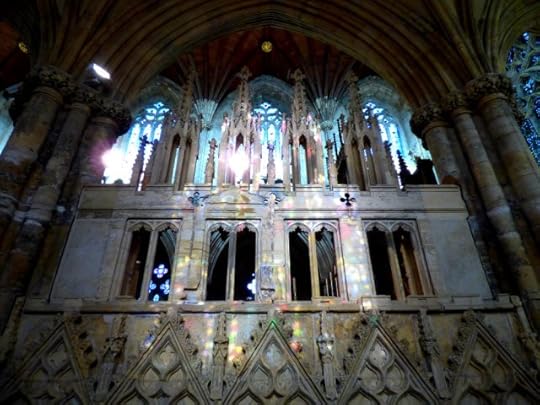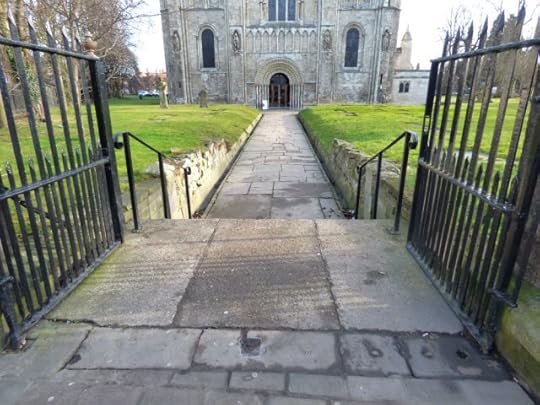Sue Vincent's Blog: Echoes of Life, page 1048
February 14, 2015
Discovering Albion – day 9: A final blaze…
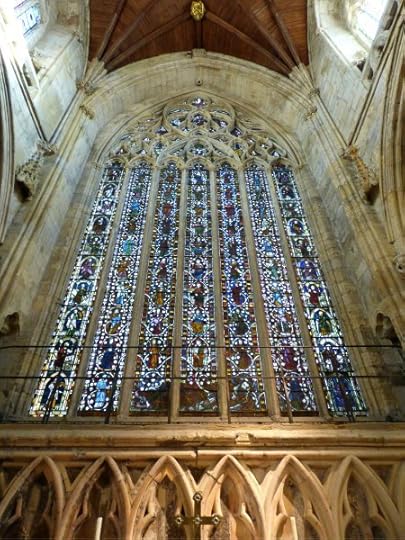
The Jesse window c.1330
(Click image to enlarge)
There is a final jewel at Selby Abbey; the great East Window. I told how the great fire of 1906 had put it in imminent danger of shattering and how a dedicated fire crew had protected the fragile panes with water. Of course there has been damage over the years and subsequent restoration, but even so, the window is thought to be one of the finest medieval survivals in the country, second only to the West Window at York Minster.
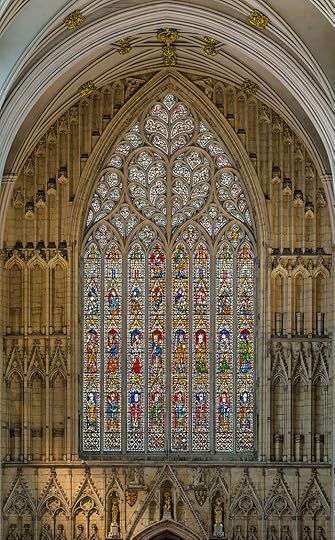
West Window, York Minster. Image: DAVID ILIFF. License: CC-BY-SA 3.0
Personally, although the tracery of stone in the upper reaches of the York window may be finer with the heart shaped centrepiece, I have to say I prefer the one at Selby… as much, perhaps, for its history as anything else. Somehow it seems more approachable and human, but then it is not set so far out of reach.
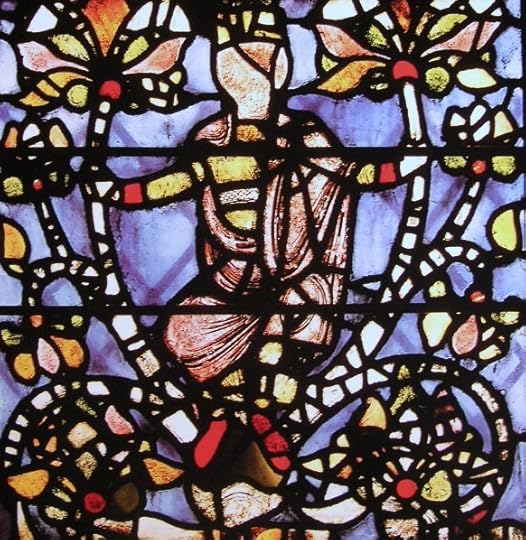
York Minster fragment of JesseTree c1170 Image: by Unknown
It is known as the Jesse window and dates from c.1330AD. There are a number of medieval Jesse windows, or fragments of them that survive through the country. A few small panes survive of the Jesse window from York Minster, dating back to around 1170AD which is thought to be the oldest surviving stained glass in England. The Selby window, however, is thought to be the most complete and finest of its period. In later centuries with the Gothic revival the subject once more became popular and we have seen some fabulous Victorian examples. But nothing as old as this.
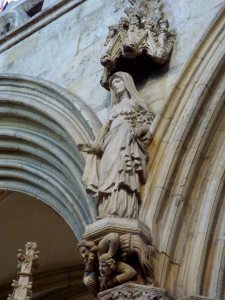 The 70 panels of the main window are arranged over seven vertical lights. These panels trace the royal line of the kings of Israel leading eventually to Mary and Jesus, thus establishing the claim that He was King of the Jews of the Royal House of David. The inspiration for this motif, common in manuscripts in the medieval period, is a line in the Book of Isaiah:
The 70 panels of the main window are arranged over seven vertical lights. These panels trace the royal line of the kings of Israel leading eventually to Mary and Jesus, thus establishing the claim that He was King of the Jews of the Royal House of David. The inspiration for this motif, common in manuscripts in the medieval period, is a line in the Book of Isaiah:
“And there shall come forth a rod out of the stem of Jesse, and a Branch shall grow out of his roots” (King James Version).
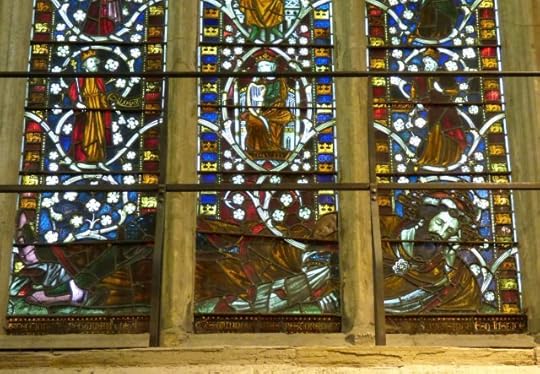 The image of a tree in this window grows from the heart of a sleeping Jesse. Lineage and hereditary position were of more importance in medieval times, especially to the nobility and clergy perhaps. Establishing and asserting the Royal Line of Jesus would have been of great importance and the two, rather contradictory, genealogies given in the New Testament would have been the subject of both debate and assertion.
The image of a tree in this window grows from the heart of a sleeping Jesse. Lineage and hereditary position were of more importance in medieval times, especially to the nobility and clergy perhaps. Establishing and asserting the Royal Line of Jesus would have been of great importance and the two, rather contradictory, genealogies given in the New Testament would have been the subject of both debate and assertion.
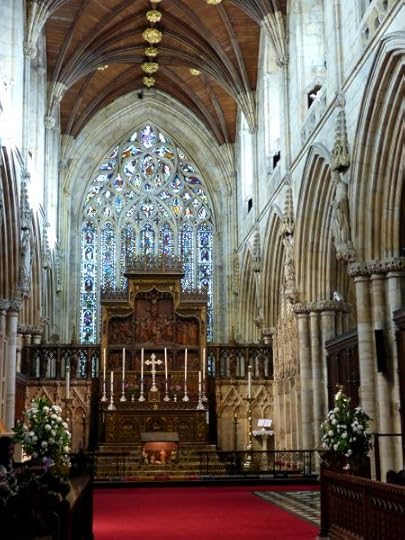 The window occupies the entire east wall of the centre of the church. It is huge. The High Altar sits a little way behind it these days, making it impossible to get a clear distant view… you would need to be up high. Its colours strew a veil of light behind the altar and the glass of the tracery at the top tells its own story.
The window occupies the entire east wall of the centre of the church. It is huge. The High Altar sits a little way behind it these days, making it impossible to get a clear distant view… you would need to be up high. Its colours strew a veil of light behind the altar and the glass of the tracery at the top tells its own story.
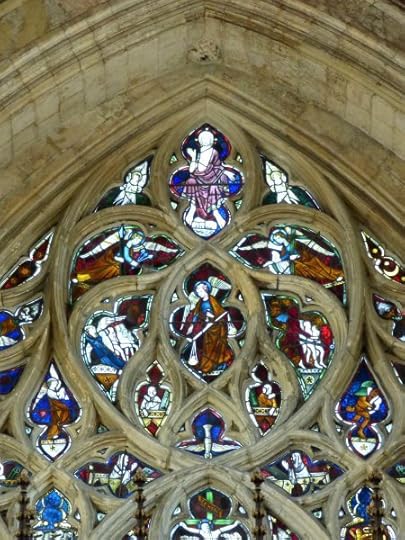 These panels show the Doom. The dead are raised from their tombs, their souls led to Judgement where they are weighed on the scales in a scene once more reminiscent of the Osirian myths of Egypt where the heart of the deceased was weighed against the feather of Truth. The good are guided away by winged angels, the sinners are rather less fortunate and are herded away by demons.
These panels show the Doom. The dead are raised from their tombs, their souls led to Judgement where they are weighed on the scales in a scene once more reminiscent of the Osirian myths of Egypt where the heart of the deceased was weighed against the feather of Truth. The good are guided away by winged angels, the sinners are rather less fortunate and are herded away by demons.
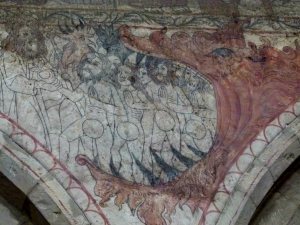
Wall painting, Pickering c.1450
These depictions of the Doom are found in many medieval wall paintings and windows, often monarchs and bishops are shown being herded away to Hell, illustrating the point that it was the purity of the soul rather than worldly success and high office which opened the gates of Heaven. I wonder sometimes if we have forgotten that in our so-called enlightened age, for the essence of that message applies equally to individuals of all faiths and none when stripped of its stories and particular symbols; it is not what we own or achieve in material terms, but who we choose to be and to become that really counts.

Discovering Albion – day 9: Faces from the past
 When the church was restored after the fire of 1906 the wooden roof had to be reinstated. Looking up today you could be forgiven for thinking this is the original work so faithfully have the beams been reproduced. The bosses, however, are, for the most part the original medieval work. The bosses were secured to the ceiling beams with wooden pins. When the flames consumed the roof of the church the pins burned away and the bosses dropped to the ground, escaping largely unharmed. Most were recovered, a few replaced and they were all later gilded, restoring the roof to its former glory.
When the church was restored after the fire of 1906 the wooden roof had to be reinstated. Looking up today you could be forgiven for thinking this is the original work so faithfully have the beams been reproduced. The bosses, however, are, for the most part the original medieval work. The bosses were secured to the ceiling beams with wooden pins. When the flames consumed the roof of the church the pins burned away and the bosses dropped to the ground, escaping largely unharmed. Most were recovered, a few replaced and they were all later gilded, restoring the roof to its former glory.
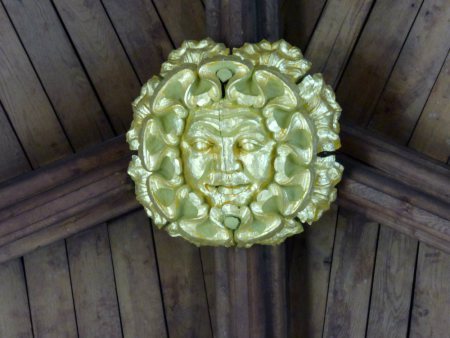
The sun in splendour?
It would need a whole book to tell the stories of those bosses. Nothing was without meaning in medieval church art. Some of the symbolism we can readily interpret, either from the records and legends that remain to us or from the perspective of modern understanding. Some elements may seem odd to our eyes and there is no doubt in my mind that some are a simple expression of humour and joy. Some meanings would have been topical and are lost to the mists of time; others speak to us at a level beyond logic.
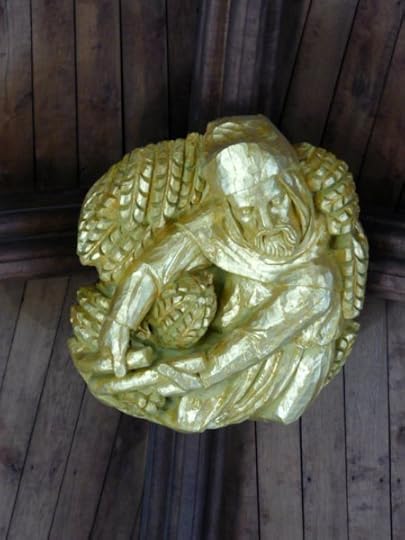
Harvesting… what?
There are scenes from the Bible and from everyday life, such as the man bringing in the harvest. Yet we have to wonder whether this is merely what it seems to be on the surface, or whether there is a deeper and more symbolic message, referring back to the biblical maxim of reaping what we sow. From the perspective of the Silent Eye, we would also look at the psychological significance of that and how what we know of life is shaped by our own reactions and perception.
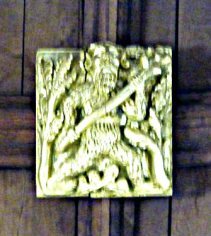
Hairy anchorite?
The sun has always been a symbol for the Son… and for the Light. Its life giving rays bathe the earth and inner Light illuminates and feeds the soul. The hairy anchorite is a familiar figure to us… the woodwose, Wildman of the woods. Almost every culture has one; in Britain we think of the Irish tale of King Buile Suibhne who was turned into a Wildman for insulting a bishop… or of Myrddin Wylt… later known as Merlin… whose feral wanderings brought prophetic vision. Or even of the story of St Kentigern … another name that keeps cropping up on our travels… where the details of the wildman Lailoken are very similar to those of Myrddin. Today we might interpret the woodwose in many ways, depending upon our perspective, from a need to conquer our baser natures, to a need to retain a connection to our deeper instincts, for it is a common factor of many of these tales that the Wildman has a wisdom that ‘civilised’ man lacks and seeks to learn from them.
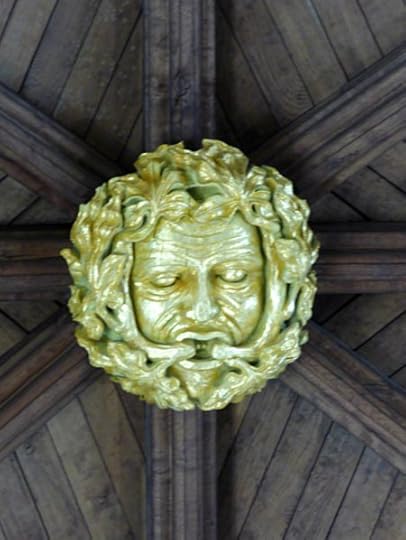
Green Man
From the Wildman it is not much of a step to the Green Man. Many writers make the connection through the tale of Gawain and the Green Knight. Books have been written on the subject… many of them… as speculation and understanding start from all points of the metaphorical compass. Some say the Green Man is the spirit of nature, others equate him with the sacrificial victims of ancient fertility rites, with Jack-in-the Green, Jack o’ Lent and even a prototype of Robin Hood.
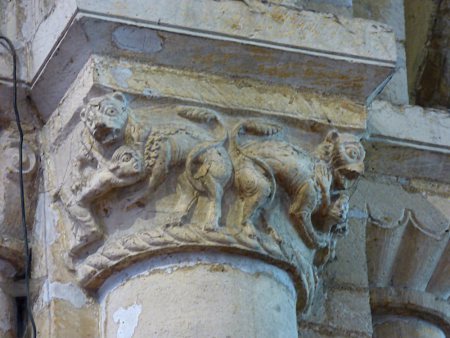
Twin beasts
Christianity tends towards an equivalence of the green, growing shoots with the death and resurrection of Jesus, although sometimes the Green Man is associated with Judas Iscariot… perhaps an understanding of the principle of necessary evil akin to that of Set as the Contender in the Egyptian Osirian myths. We may never know the true meaning the symbol had for those who carved it…perhaps it is enough that it makes us think… but there is at least one Green Man, very often more, in many of our older churches.
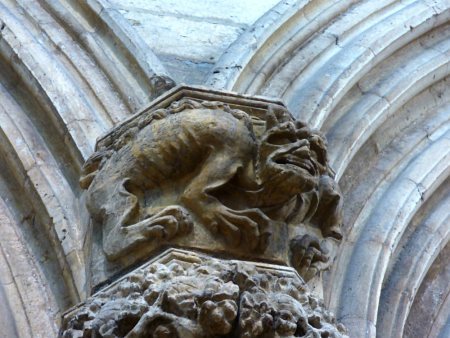
The Selby Imp
There are strange, otherworldly creatures and demons in glass, wood and stone, like the Selby Imp who clings to a column to the south side of the High Altar. Stories in stone that we cannot read with any certainty, like the twin beasts with the human figures… wrestling, hunting or hunted… who knows? Do they warn of the devouring nature of sin or promise victory to the faithful?
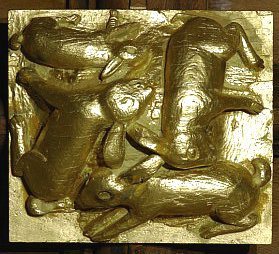
Three hares share three ears…
Three enigmatic hares share three ears between them… a symbol of fertility…of the Trickster figures of mythology… of the Trinity… there are no records to tell us what it meant to those who carved it, but it is a symbol that occurs across many lands and faiths. It is a symbol with a personal significance for me for many reasons and on Sunday my granddaughter will be christened in the little church close to my home where its earliest representation in Britain hides on a small tile by the altar.
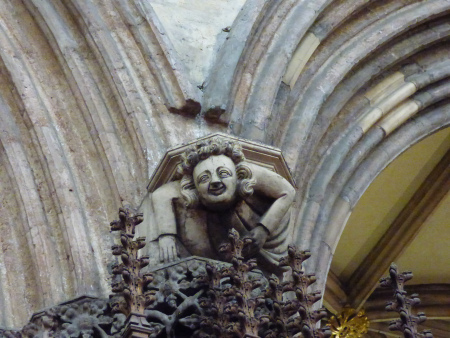
Caricature? Portrait? Or something more symbolic?
Everywhere you look it seems that eyes look back from caricatures, portraits and beasts of a warped imagination. Look at the serne statue of a bishop and you notice the figure beneath his feet. Look closer and faces stare from the canopy above his head… and beside his feet, two people…or one carrying a head? It is not enough to simply visit places such as Selby Abbey; you have to look, really look… and what you see will leave you with food for thought for years to come.
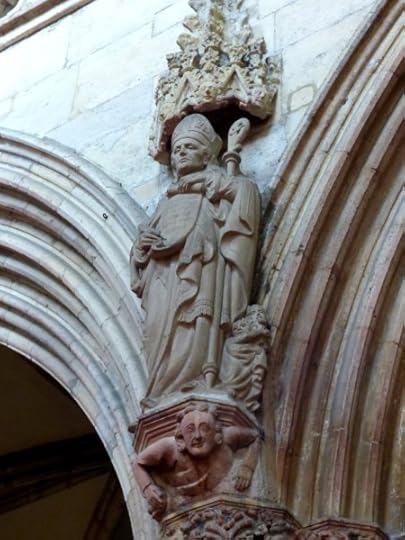
Surrounded…
Discovering Albion – day 9: Phoenix
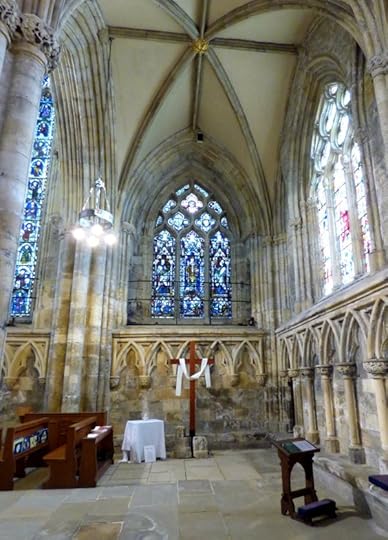 “From the ashes a fire shall be woken,
“From the ashes a fire shall be woken,
A light from the shadows shall spring…”
Tolkien, Lord of the Rings
Just before midnight, October 19th 1906, workers who had been installing a new system in the organ saw flames in the window. Soon fire raged through the building. Glass shattered, flames leaped through the roof, the towers acted as great chimney belching smoke…silver streams of molten lead poured into the church… Selby Abbey was burning. It wasn’t the first time.
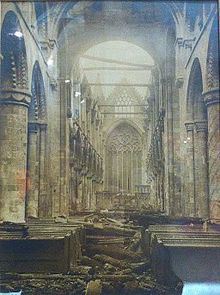
Image © Selby Abbey
There had been a fire too in 1340 which had caused extensive damage. Parts of the church had never recovered. This time, however, the damage was worse. Fire crews battled to save the Abbey. A special crew were dedicated to an attempt to preserve the great treasure of the East window, keeping it cool and wet against the flames in a desperate effort to protect the 14th century glass.
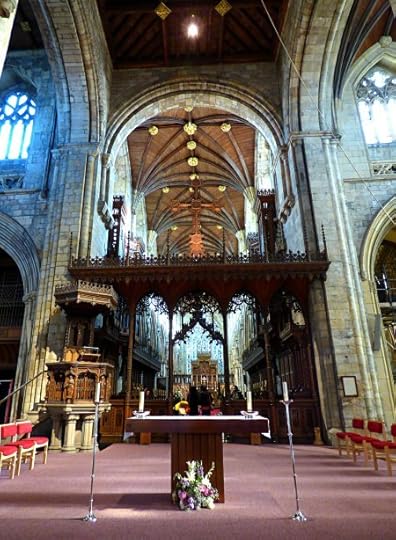 The roof of the choir and belfry were destroyed as was the interior woodwork and much of the glass. A peal of eight bells in the tower had melted. The devastation of the Abbey, which had survived so long, seemed complete. Given the level of devastation, it would have been understandable if only a chapel had been preserved for future worship and the rest allowed to fall into ruin. The people of Selby, however, had other ideas.
The roof of the choir and belfry were destroyed as was the interior woodwork and much of the glass. A peal of eight bells in the tower had melted. The devastation of the Abbey, which had survived so long, seemed complete. Given the level of devastation, it would have been understandable if only a chapel had been preserved for future worship and the rest allowed to fall into ruin. The people of Selby, however, had other ideas.
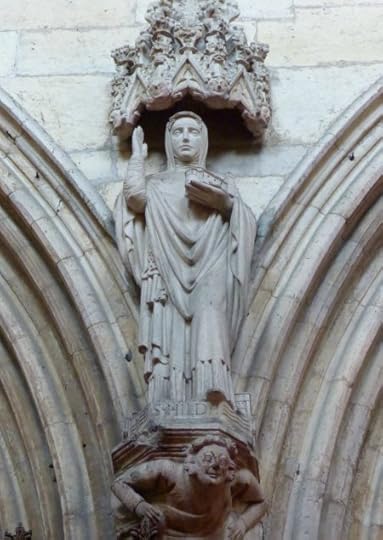 Within hours a restoration fund had been established. Money poured in from across the country. Townsfolk stood at the gates of the Abbey and held sheets into which visitors threw money. The Abbey, it seemed, would, like the proverbial phoenix, rise once more from its own ashes.
Within hours a restoration fund had been established. Money poured in from across the country. Townsfolk stood at the gates of the Abbey and held sheets into which visitors threw money. The Abbey, it seemed, would, like the proverbial phoenix, rise once more from its own ashes.
“…And so long as you haven’t experienced
this: to die and so to grow,
you are only a troubled guest
on the dark earth.”
Goethe
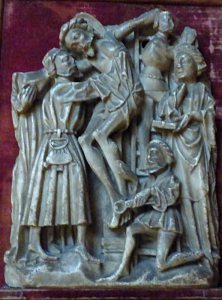 The restoration began. The foundations, laid on the meagre three feet of sand, had caused collapse in 1690. At that time the central tower had collapsed, destroying the south transept, and while the tower had been rebuilt, the transept had remained in ruins. Sir George Gilbert Scott had restored the church in the 19th century, but it was not until the fire of 1906 that a complete restoration was undertaken.
The restoration began. The foundations, laid on the meagre three feet of sand, had caused collapse in 1690. At that time the central tower had collapsed, destroying the south transept, and while the tower had been rebuilt, the transept had remained in ruins. Sir George Gilbert Scott had restored the church in the 19th century, but it was not until the fire of 1906 that a complete restoration was undertaken.
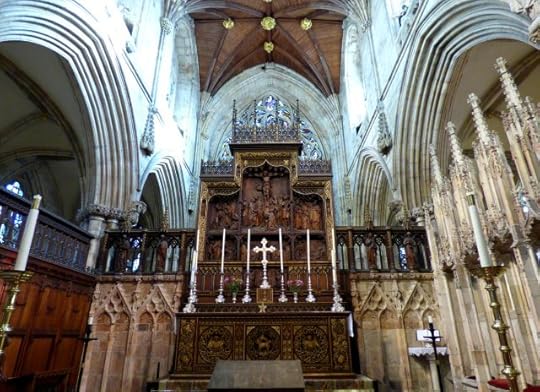 Every scrap of flame blackened stone had to be cleaned. Woodwork and glass needed to be painstakingly replaced. Yet work progressed rapidly. The nave was rededicated within a year. The tower restored within three. The south transept, which had never been rebuilt after the collapse in 1690 was rebuilt, funded by William Liversedge and reopened in 1912. John Oldrid Scott supervised the painstaking task of bringing the Abbey back to its former glory, conserving and preserving its fabric and beauty for the future. In 1935 Charles Marriott Oldrid Scott raised the height of the west towers and, for the first time in its history, the Abbey was finally complete, consolidated and able to show its true beauty to the world undamaged.
Every scrap of flame blackened stone had to be cleaned. Woodwork and glass needed to be painstakingly replaced. Yet work progressed rapidly. The nave was rededicated within a year. The tower restored within three. The south transept, which had never been rebuilt after the collapse in 1690 was rebuilt, funded by William Liversedge and reopened in 1912. John Oldrid Scott supervised the painstaking task of bringing the Abbey back to its former glory, conserving and preserving its fabric and beauty for the future. In 1935 Charles Marriott Oldrid Scott raised the height of the west towers and, for the first time in its history, the Abbey was finally complete, consolidated and able to show its true beauty to the world undamaged.
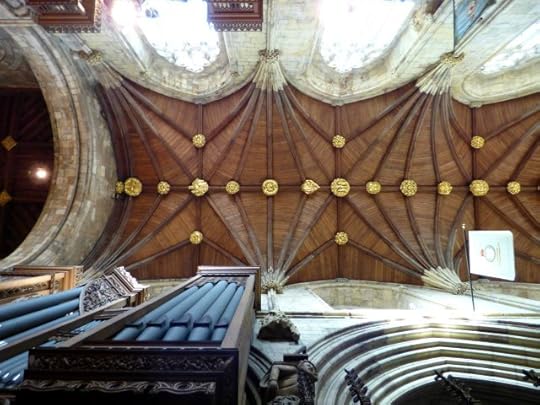 It is only because of the flames that the church was able to be reborn whole and complete. Without the disaster would it simply have known the constant struggle against time and decay that is familiar to us all? From apparent devastation something beautiful emerged, a butterfly from the cocoon. This too is part of the human story… who amongst us has not seen those radiant ones who come through disaster to shine the light of the human spirit and inspiration into the dark corners of our own despair?
It is only because of the flames that the church was able to be reborn whole and complete. Without the disaster would it simply have known the constant struggle against time and decay that is familiar to us all? From apparent devastation something beautiful emerged, a butterfly from the cocoon. This too is part of the human story… who amongst us has not seen those radiant ones who come through disaster to shine the light of the human spirit and inspiration into the dark corners of our own despair?
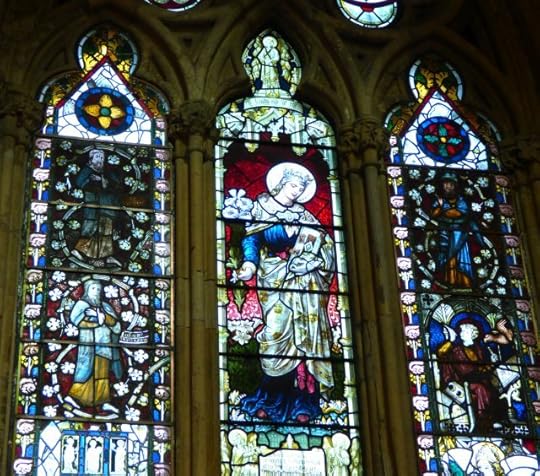 A thousand years of history lie in these stones. Two thousand years of faith echo in these quiet chapels as whispered prayers. It was the love of the local people for this scarred and ravaged beauty that gave her once more the strength to shed her veil and stand proud and glorious to face the world. Love can work miracles. From ruin to the delicate bridal veil of light and colour she was brought, reborn and clean, made whole through love.
A thousand years of history lie in these stones. Two thousand years of faith echo in these quiet chapels as whispered prayers. It was the love of the local people for this scarred and ravaged beauty that gave her once more the strength to shed her veil and stand proud and glorious to face the world. Love can work miracles. From ruin to the delicate bridal veil of light and colour she was brought, reborn and clean, made whole through love.

February 13, 2015
Discovering Albion- day 9: Royalty and the American Flag
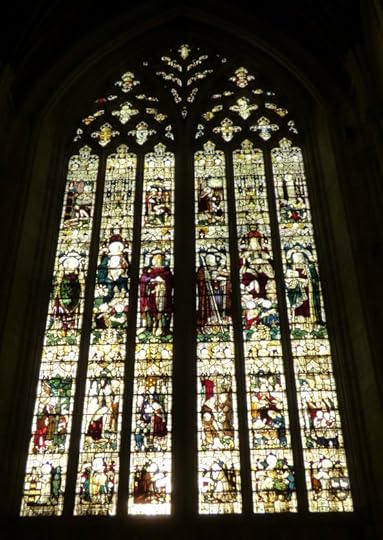
Window in the south transept c.1914 (Click to view larger image)
Another huge window fills the end wall of the south transept, showing scenes from the early history of the Abbey at Selby. On both walls the stained glass depict members of the Royal House; on one side Victoria Queen and Empress with Albert, the Prince Consort, on the other Edward VII and his queen, Alexandra.
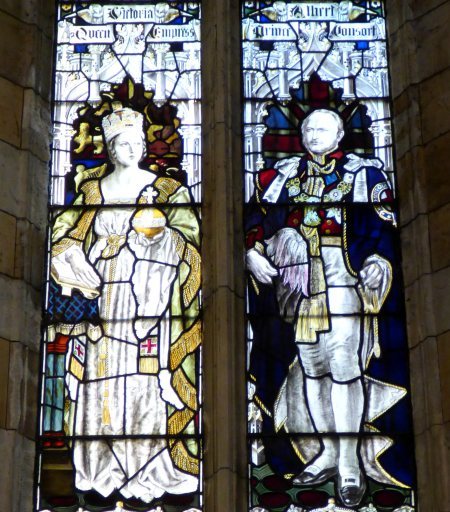
Victoria, Queen Empress and Albert, Prince Consort
For me, however, this little corner holds memories far more personal. I remember standing here with my Grandma Annie as she told me about the tradition of Maundy Money. There is a little display case with the purses and coins that Queen Elizabeth handed out to parishioners here in 1969 at the time the nine hundredth year of the Abbey., the only time the Royal Maundy Service had been held in a Parish Church rather than a cathedral.
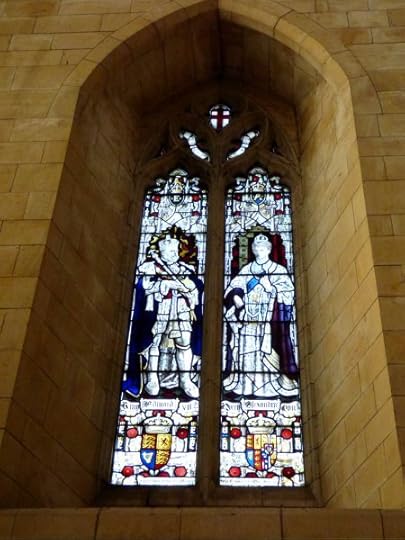
King Edward VII and Queen Alexandra
The Royal Maundy Service is an ancient tradition that has evolved over the centuries from the instruction of Jesus … the mandatum… given to His followers at the Last Supper. He told them to love one another. In medieval England the monarchs would, on Maundy Thursday, and on other Maundy days throughout the year, wash the feet of the poor in the rite known as pedilavium. They would be given food and clothing as alms. King John is the first monarch in recorded history to have performed this act in 1210AD, though the bishops and other personages had done so for centuries.
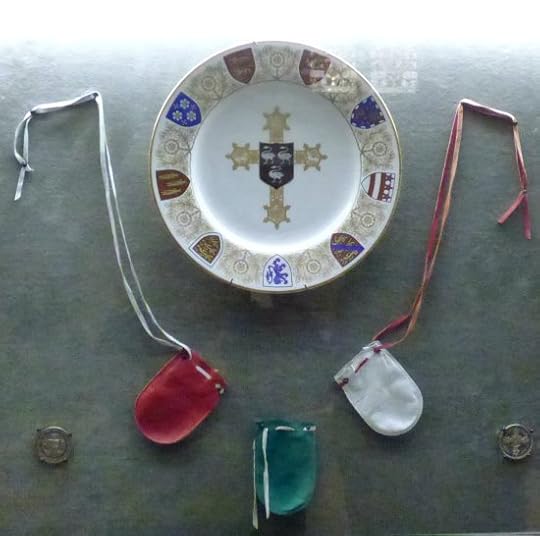
Maundy purses and coins
Today the Maundy Service is one Queen Elizabeth, known for a deep and real faith, participates in every year. Specially minted coins are given out these days, instead of goods, to a number of pensioners from the parish; one for every year of the monarch’s life and while the coinage is a nominal sum and legal tender, their value to collectors is much higher.
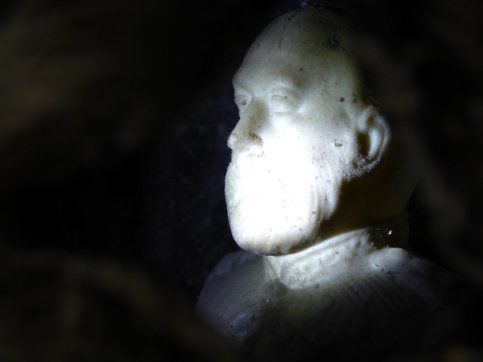
Portrait bust no larger than a baby’s fist
Of course, there are other allusions to royalty within the church…one a very curios sculpture that you would miss if it were not pointed out and a torch provided! Within one of the small, pierced bundles of carved stone foliage you are directed to shine the beam of the torch… and there you find a tiny white portrait bust of King Edward VII. It is not the only such surprise, though the others you have to look for… Tiny portraits and creatures are hidden in other carvings too.
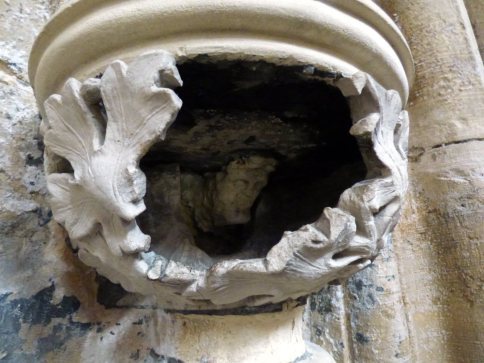
Stuart spotted this one… obviously older. How many more lie hidden?
Then there is another very curious detail; one of the clerestory windows above the main altar is part of the American Heritage Trail. The American flag flies there, marking an unexpected connection. I remembered my grandmother telling me about this too, so I had been looking for it. It would be easy to miss if you did not know, though a corner of the church celebrates this snippet of history.
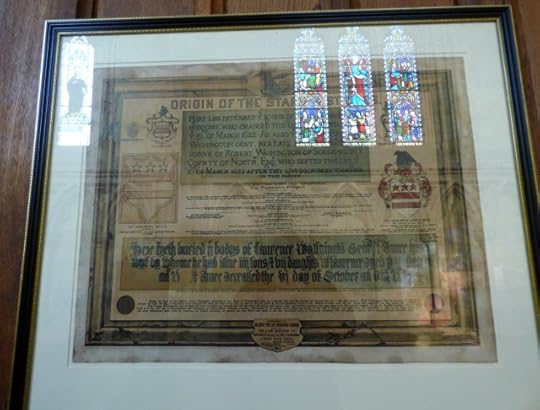
Transcript of the inscription from the tomb of Lawrence Washington (click to enlarge image)
The window bears the coat of arms of one of George Washington’s ancestors, John Wessington, who was… oddly for us… Prior of Durham .The 14th century stained glass shows a shield which bears his coat of arms; three red stars and two red bars on a white ground. Another representation of the crest is in Northamptonshire, at a church associated with the Spencer family… coincidentally my grandmother’s surname. That one is dated a couple of hundred years later and can be found on the tomb of Lawrence Washington, a direct ancestor of George. This is the same crest that was found inside a book and on two seals belonging to George Washington himself. The story says that this is where the Stars and Stripes had their origin. Odd to think that the earliest known version of the Stars and Stripes may be on the window of a Yorkshire parish church.
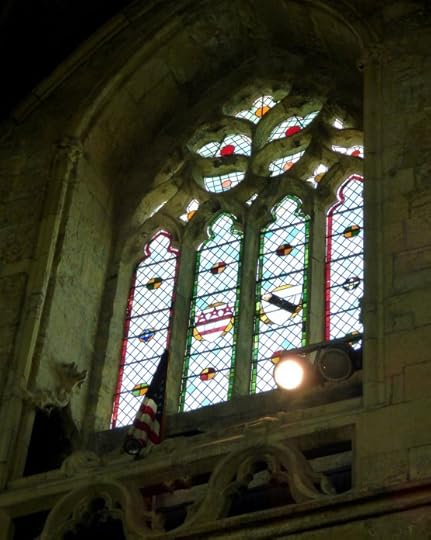
The origin of the Stars and Stripes… (click image to enlarge)

Discovering Albion – day 9: Interwoven threads
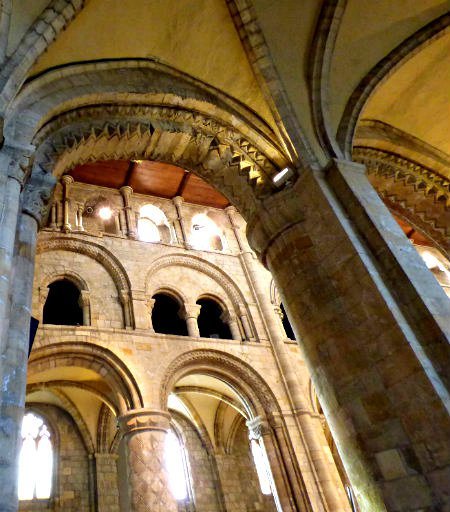
Carved Norman arches, with Abbot Hugh’s Pillar in the centre. The distortion of some the arches is due to the church being built on sand.
We walked down the Norman nave, passing Abbot Hugh’s pillar, identical to those at Durham cathedral where we had been the day before. Was it only the previous day? Similar too to the great carved columns of Dunfermline a few days earlier. For an unplanned trip we seem to have followed a trail where several strands were interwoven in a continuous knot like the interlaced pattern of the Celtic stones.
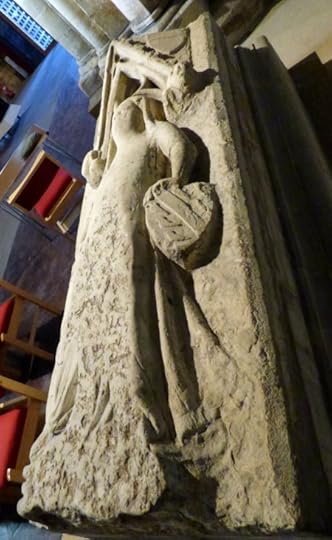
Tomb of Margaret de Pickworth, her husband lies in the aisle opposite.
We passed between the tombs of knights and their ladies… of bishops and dignitaries carved in stone to be remembered. How little we change, after all, across time and borders… how different in essence are our tombs and our desire to remain in human consciousness… to leave an indelible memory and our mark upon the world which is the cradle of our souls.
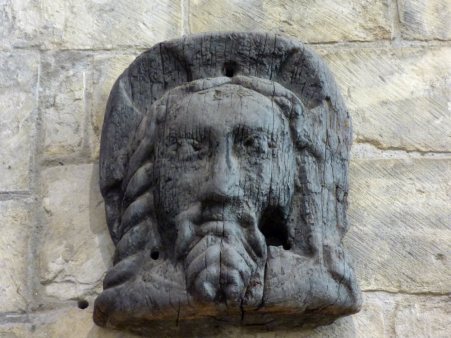
Fire blackened beauty
Near the Crossing a blackened wooden head… Christ or the Baptist perhaps… hangs on the wall. Its expression is one of both quiet joy and serenity. I can find no reference to dates or origin, but I wondered if the carving was a survival of one of the two fires that have decimated the church. Strange to think that without the apparent destruction the building would not have evolved into the beauty it is today.
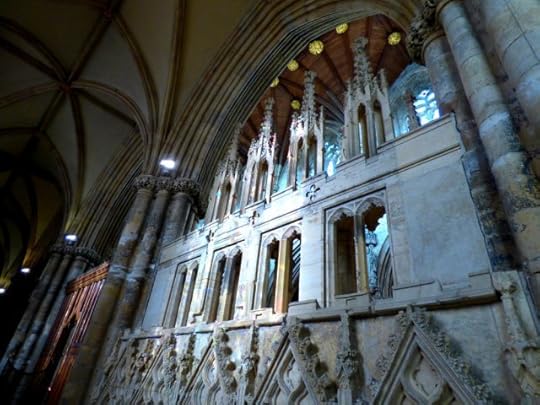
Light plays in the south aisle
The Abbey has an unusual triple dedication to Our Lord, the Blessed Virgin Mary and St. Germain, the saint being seen as the patron of the church. His is an unusual story. He was born in the 378 or 380AD at Auxerre in France, and rose to military and social prominence. The Bishop of Auxerre saw in him a spiritual potential, but Germain resisted all attempts to turn him to the Church. The bishop kidnapped him, bound him and locked him in the church before shaving Germain’s head with the monastic tonsure. Oddly, Germain accepted this calmly and went on to become a monk and a truly saintly man.
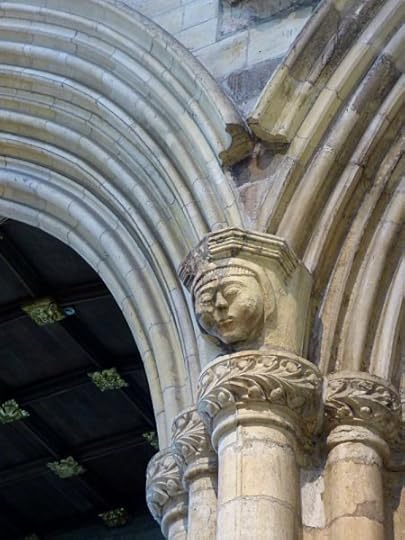
Details and curious characters cover the stonework and all the gilded roof bosses
He came to Britain and preached, converting many to Christianity and even led the British against the Picts and Scots to gain the bloodless “Alleluia victory” in 430AD where he had the concealed army cry the paean three times so loudly the enemy, thinking themselves outnumbered, turned and fled. Close to the town of Selby a field is still known as Garmon Carr… Garmon was the name by which he was known in England. It is possible the saint visited the area. Oddly, given the trail of clues we had been following, Germain is thought to have been a teacher of St Patrick.
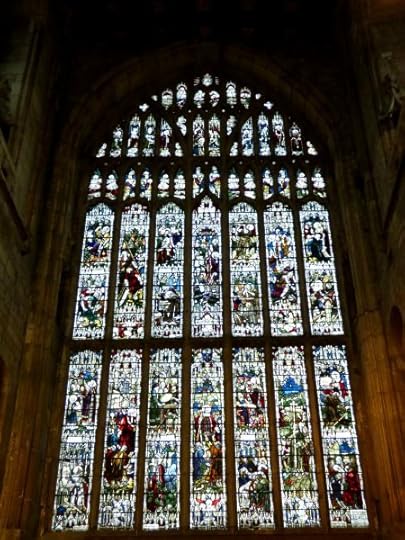
The St Germain window from 1914 replaced the shattered medieval glass. It shows 46 scenes from the story and legend of the saint and is unique in the world (Click image to see detail full size)
Germain was known for his dreams and visions. One of his major sermons in Britain was at St Albans, then Roman Verulamium, where St Alban, the first British Christian martyr, had been beheaded. Alban revealed himself to Germain in a vision and his cult grew from that point. It was another vision sent Benedict to Selby to found the Abbey. He dreamed that Germain had told him to found a great abbey at ‘Selebiae’ where three swans would mark the spot. After wandering far, Benedict found the bend in the Ouse where three swans alighted and the birds have been the symbol of the Abbey ever since.
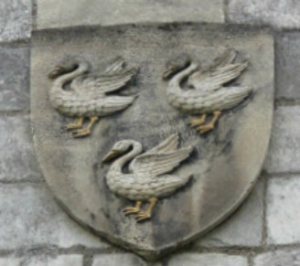
The three swans are the emblem of Selby Abbey and Benedict saw them as symbolic of the Trinity
Not all the monks from Selby were so saintly however, nor did they always follow the Rule of St benedict to the letter. The 13th century saw visitations by various Archbishops who found that the resident bishop was failing in his ecclesiastical duties by not singing Mass, conducting prayer or preaching. He wasn’t even turning up in the Chapter House for meetings. Though that may or may not have been worse than the findings of the previous Archbishop, called in to deal with the monks after complaints of their dealings with married women… How many stories could these walls still whisper?
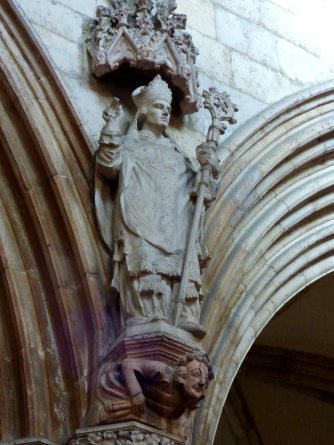
Perhaps there is a reason for the strange creatures upon which the carved figures stand…?
Discovering Albion – day 9: Dignity and memories
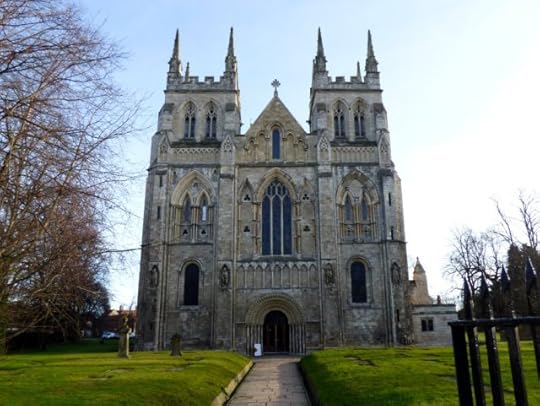
“…a stately old lady, retired to the country with her dignity and memories intact.” Simon Jenkins on Selby Abbey.
The Anglo-Saxon Chronicle of AD 779 mentions a settlement called Seletun. Arcahaeological remains show it to have been first settled by the Vikings and there was an extensive Roman presence. Today the little town of Selby still straddles the banks of the Ouse in the West Riding of Yorkshire. These days, since the reordering of the counties, it belongs officially to North Yorkshire, but the less said about governmental interference with our Ridings the better. The Ridings themselves cannot be changed by the transience of politics. There are three Ridings …from Thirdings, it is thought… North, West and East; we dispensed with the south. The Ridings meet in the Vale of York… the Ainsty.
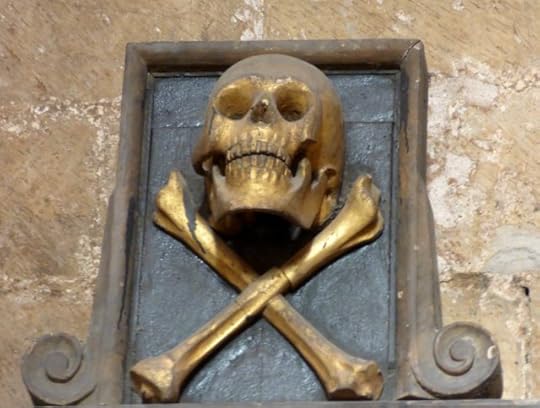
You don’t mess with the Ridings…
To be fair, Selby Abbey isn’t actually a cathedral, just a normal Parish Church… though I know many a parish church that would fit comfortably within the walls of its vestry, and many a cathedral that would be dwarfed by its size and magnificence. I had been there before, long, long ago, before I had any real knowledge and no understanding of anything other than the beauty I found within its walls.
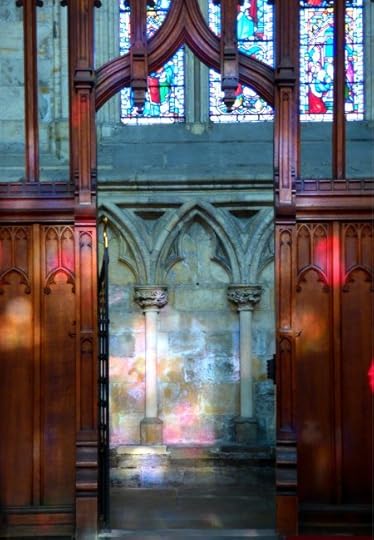
Sunlight in flower
Still, the memory is a fond one. I had been taken by my grandparents when we had gone to visit great grandmother. She had gone blind one day on her way to work one day… already well past retirement age, of course… and was being cared for in Selby. I remember a few things from that early visit… like the Stars and Stripes and the story of the Maundy Money which Grandma Annie told me outside the south door of the Abbey, showing me where the queen had stood.
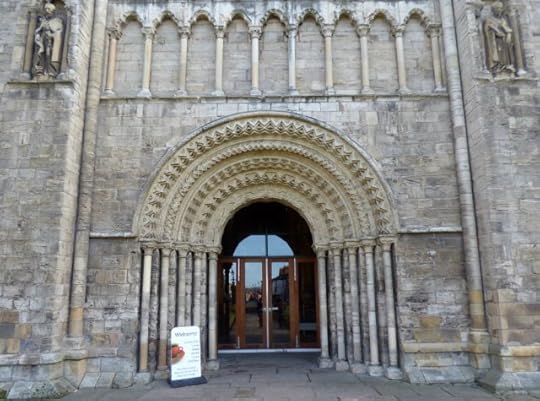
The Norman West door
So, although I had been inside the church before that was more than forty years ago and I knew little of what to expect. The exterior I knew well by sight, but again, I’d had insufficient knowledge to form any understanding of it back then. Seeing its beauty was enough for the youngster. Coming back armed with greater knowledge to something I had thought familiar was an object lesson in the errors of preconception and a graphic reminder that the more knowledge we bring to anything we do, the wider the gates of understanding will stand open to allow us to pass within.
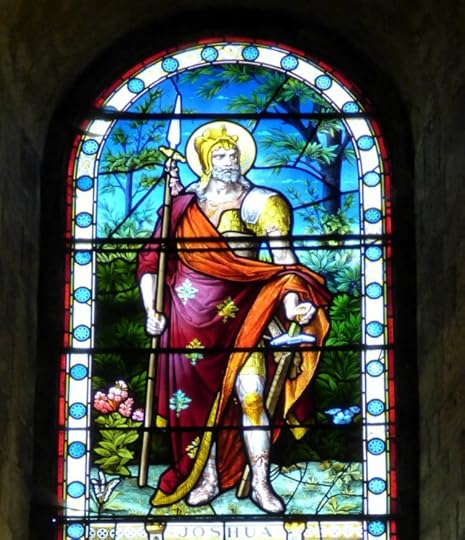
“Be strong and courageous…” Joshua 1:6
Standing at the gate we saw a beautiful building… obviously Norman going by the intricacy of the carved arch of the West Door and the weathering of the stonework. Even if it proved to be a restoration, the proportions were ‘right’. It had always been there. The whole frontage suddenly becomes an inventory of periods based on the shape of the towers and the windows, the arches and columns and you begin to read its story in its very fabric as you approach. The lower tier is Norman, almost a thousand years old. The next tier medieval Early Gothic, the towers, rather short and square, are Victorian. It had the feel of George Gilbert Scott’s hand in it too… and that proved to be correct. We have seen much of his work on our travels.
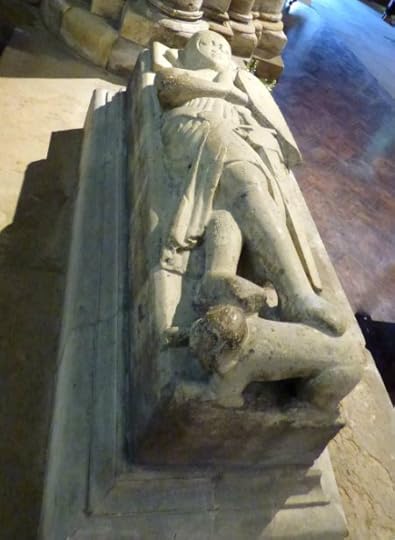
Hugh de Pickworth c.1325
It seems incredible that only a couple of years ago, before Stuart and I began our adventures with the books, our knowledge had been somewhere between rudimentary and non-existent. We are by no means experts… that would take a lifetime apiece… but we have been privileged to learn a good deal on our wanderings.
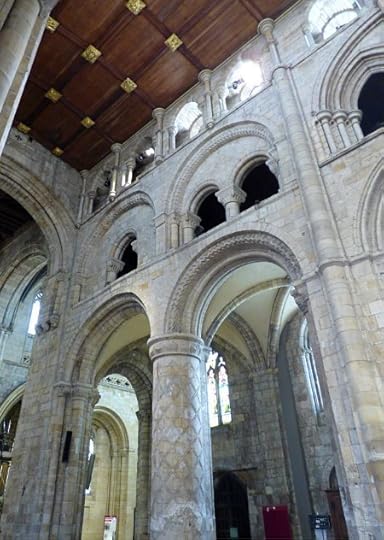
Pillars reminiscent of Durham Cathedral… builders marks in the two churches show that some of the same masons worked on both buildings. The pillar with the diamond pattern is Abbott Hugh’s Pillar… Hugh trained at Durham.
The church was founded in 1069 as a Benedictine Abbey and built by the de Lacy family. Not an easy build, as like the great Minster at York the foundations rest on just three feet of sand above the water table. The builders had to let the structure settle onto wooden beams sunk into the unstable ground. Unsurprisingly parts of the building collapsed in the 17th century causing extensive damage and reconstruction. What is more surprising is that, given the unpromising instability of the ground, the great church stood undamaged for half a millennium. A fire destroyed many of the monastic buildings in 1340 and caused damage to the church which was rebuilt.
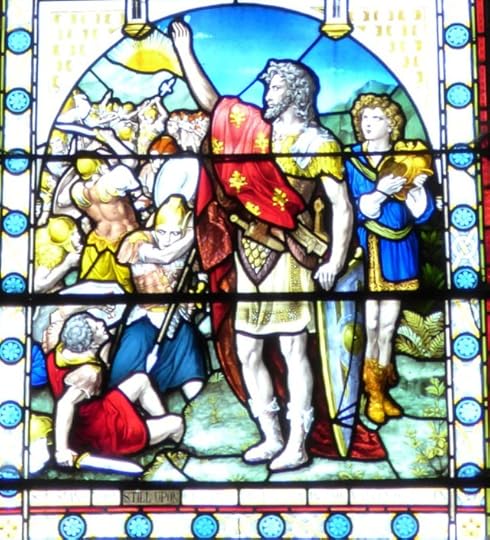
Lower panel of the Joshua window
The church itself survived the Dissolution of the Monasteries in the 16th century, though most of the monastic buildings are now gone. In 1618 it became the Parish Church for the town. A fire caused a huge amount of damage in 1906, melting a peal of bells in the tower with the heat. Somehow, due to the diligence of the firemen, the great, medieval East Window survived in all its glory. The reconstruction and restoration of the church was begun yet again and what remains can, perhaps, be called a testament to Yorkshire grit… that stubborn determination that rolls up its sleeves and refuses to surrender. What remains is something very special…
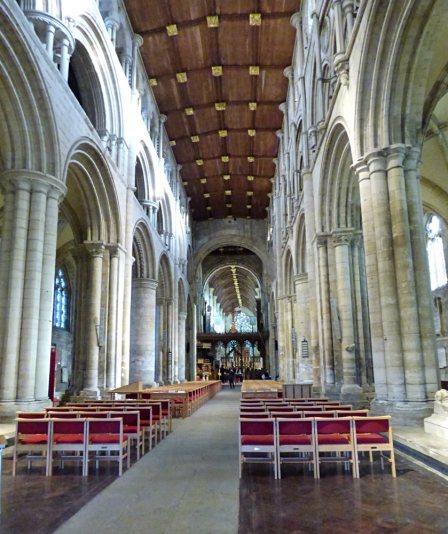
The Nave from the West door: the triforium arcade supported on huge pillars, the clerestory above where light streams in.

February 12, 2015
Discovering Albion – day 9: Back to St Andrews?
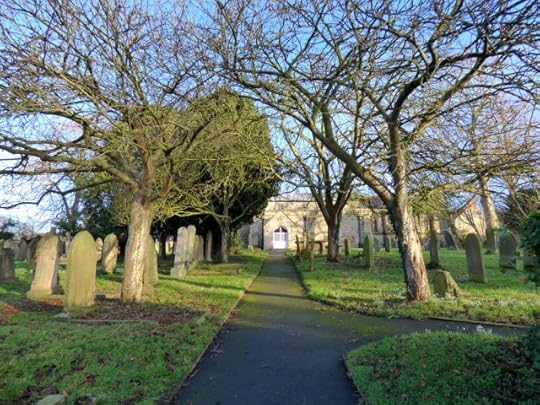 Yes, we were heading back to St Andrews… no, not the one in Scotland, sadly… though I would, given half a chance. In fact, I mused, I could pretty much never come home given a camper van and some way to make enough to survive… I should have been a gypsy… I was daydreaming. And while I have nothing against that at all, I probably shouldn’t be indulging whilst driving.
Yes, we were heading back to St Andrews… no, not the one in Scotland, sadly… though I would, given half a chance. In fact, I mused, I could pretty much never come home given a camper van and some way to make enough to survive… I should have been a gypsy… I was daydreaming. And while I have nothing against that at all, I probably shouldn’t be indulging whilst driving.
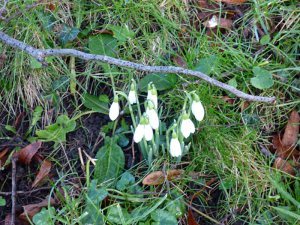 We were going back to St Andrew’s church… the one we had passed the previous evening. The one that had Stuff in it. A brief foray on the internet had produced the information that it held “some remarkable Jellinge style Viking/Christian crosses”… I liked the plurality of that … as well as an “internationally significant Anglo – Scandinavian Collection of funeral carvings and other artefacts.” Not to mention a Saxon tower on a Norman church and some intriguing stained glass. As a final stop it sounded perfect. It was a beautiful morning. And there was an 8th century cross inset into the wall of the Saxon tower… not that we knew it at the time… I only noticed it today on the photos…
We were going back to St Andrew’s church… the one we had passed the previous evening. The one that had Stuff in it. A brief foray on the internet had produced the information that it held “some remarkable Jellinge style Viking/Christian crosses”… I liked the plurality of that … as well as an “internationally significant Anglo – Scandinavian Collection of funeral carvings and other artefacts.” Not to mention a Saxon tower on a Norman church and some intriguing stained glass. As a final stop it sounded perfect. It was a beautiful morning. And there was an 8th century cross inset into the wall of the Saxon tower… not that we knew it at the time… I only noticed it today on the photos…
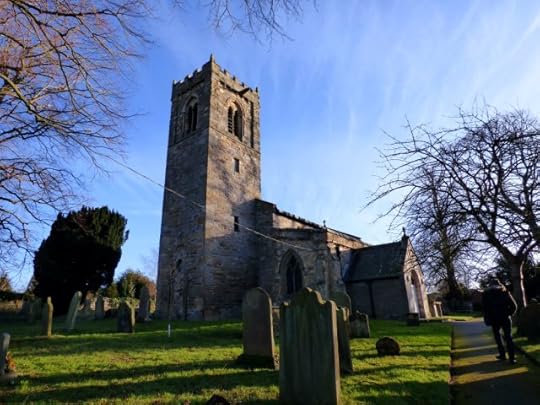 “The church building is open daily from dawn to dusk, and is a beautiful place” it said. Except it wasn’t. Open, that is. And we’d lingered over breakfast… we were in no hurry after all. But the door was shut. The way barred. We were being frustrated at the last hurdle. A local lady kindly informed us that the keyholder lived down one of the back lanes and would probably be along soon, so we lingered a little amid the snowdrops, then drove into Pickering in a futile search for a place to get the headlight fixed. Then we came back… and it was still locked.
“The church building is open daily from dawn to dusk, and is a beautiful place” it said. Except it wasn’t. Open, that is. And we’d lingered over breakfast… we were in no hurry after all. But the door was shut. The way barred. We were being frustrated at the last hurdle. A local lady kindly informed us that the keyholder lived down one of the back lanes and would probably be along soon, so we lingered a little amid the snowdrops, then drove into Pickering in a futile search for a place to get the headlight fixed. Then we came back… and it was still locked.
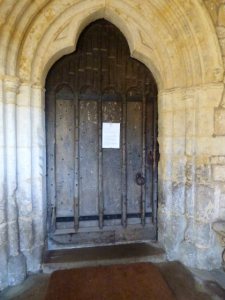 So what could we do? There were no keyholder contact details and to be fair it was a Saturday morning in January. We simply turned the car for home, deciding to take the long way back, cross country, instead of the direct A-roads and motorways. We weren’t even certain we would be able to get into back Sheffield anyway. If the local weather sage in the New Inn was to be believed the snow had fallen and more was forecast. We would meander and see what happened.
So what could we do? There were no keyholder contact details and to be fair it was a Saturday morning in January. We simply turned the car for home, deciding to take the long way back, cross country, instead of the direct A-roads and motorways. We weren’t even certain we would be able to get into back Sheffield anyway. If the local weather sage in the New Inn was to be believed the snow had fallen and more was forecast. We would meander and see what happened.
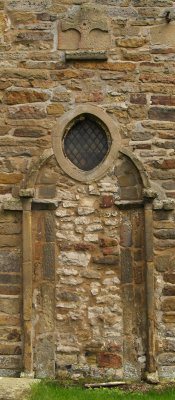
Image: Doc Brown
Click the link to see what else we missed :(
We waved to the distant spires of York Minster as we passed. They rise above the plain, high above the ancient walls of the city, towering above even the modern buildings. One of these days we would have to go there. But not today. We still had no headlight and needed to get it replaced long before the light could fade. We stopped at a garage… purely because a hawk was hovering in front of it. I tried unsuccessfully to get a decent shot then went in and asked for the nearest place to get the light fixed.
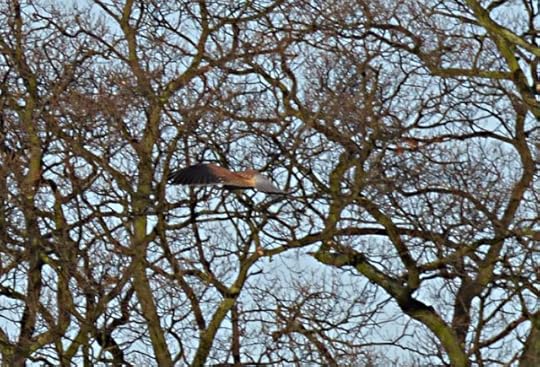 “Oh,” said the assistant, “there’s a Halford’s in Selby.” Which, of course, was just a mile or two down the road. And now we had a reason to stop there. I knew Selby well. Once I had known it very well, in fact. My great-grandmother had lived there for a while and so had an early boyfriend… at boarding school just outside the town. There had been the stock auctions where my father bought pigeons… and, of course, there was the Cathedral. A very special place. It looked as if, thanks to the hawk, we were going to get our grand finale after all…
“Oh,” said the assistant, “there’s a Halford’s in Selby.” Which, of course, was just a mile or two down the road. And now we had a reason to stop there. I knew Selby well. Once I had known it very well, in fact. My great-grandmother had lived there for a while and so had an early boyfriend… at boarding school just outside the town. There had been the stock auctions where my father bought pigeons… and, of course, there was the Cathedral. A very special place. It looked as if, thanks to the hawk, we were going to get our grand finale after all…

Discovering Albion – day 8: Over the moors
 We left Whitby, continuing our route southwards through Yorkshire along a road we had travelled together once before. “We’ll have to go to Whitby,” we had said back then. “In winter,” we had added, looking at the steady stream of traffic crossing the North York Moors. We had been looking out over the heather covered Hole of Horcum, after an utterly magical morning and a very odd meeting with a sagacious llama. The sun was warm on our backs and the moors looked at their beautiful best. They looked a bit different now as my sanity was called into question while I waded through the snow to the same vantage point. Equally beautiful, to my prejudiced eyes, of course. But different. Whiter. And colder.
We left Whitby, continuing our route southwards through Yorkshire along a road we had travelled together once before. “We’ll have to go to Whitby,” we had said back then. “In winter,” we had added, looking at the steady stream of traffic crossing the North York Moors. We had been looking out over the heather covered Hole of Horcum, after an utterly magical morning and a very odd meeting with a sagacious llama. The sun was warm on our backs and the moors looked at their beautiful best. They looked a bit different now as my sanity was called into question while I waded through the snow to the same vantage point. Equally beautiful, to my prejudiced eyes, of course. But different. Whiter. And colder.
 It was getting towards dusk too. The sun had long since set behind the hills and the only light was that which lingered in the sky. There are no street lights on the moors and we had still been unable to find anywhere to get the bulb changed in the headlight… a job I would do myself in minutes on any other car than a Puma. Even the experts struggle.
It was getting towards dusk too. The sun had long since set behind the hills and the only light was that which lingered in the sky. There are no street lights on the moors and we had still been unable to find anywhere to get the bulb changed in the headlight… a job I would do myself in minutes on any other car than a Puma. Even the experts struggle.
 Mind you, just for once we actually had a vague idea where we might end up that night. I had come across reference to a little church just outside Pickering where there appeared to be a number of fragments of old carved stone… and there just happened to be a pub in the village, right next door, where they did accommodation. Perfect for an early start on our last day on the road.
Mind you, just for once we actually had a vague idea where we might end up that night. I had come across reference to a little church just outside Pickering where there appeared to be a number of fragments of old carved stone… and there just happened to be a pub in the village, right next door, where they did accommodation. Perfect for an early start on our last day on the road.
 Pickering we had visited on our earlier jaunt, calling at the church there to see the most fabulous medieval wall paintings. We had explored the area over a long weekend of summer and heather, climbed hills, forded more streams than we had hot dinners, chased a disappearing Roman road and found revelations in stained glass amid the scarecrows. The whole thing about the Simeon windows goes back to that trip and we told the story in our book Heart of Albion… as well as on the blog.
Pickering we had visited on our earlier jaunt, calling at the church there to see the most fabulous medieval wall paintings. We had explored the area over a long weekend of summer and heather, climbed hills, forded more streams than we had hot dinners, chased a disappearing Roman road and found revelations in stained glass amid the scarecrows. The whole thing about the Simeon windows goes back to that trip and we told the story in our book Heart of Albion… as well as on the blog.
 It was late afternoon and almost dark as we turned right in Pickering towards Middleton and the little church with its convenient inn… which had inconveniently closed and taken down its sign. Driving on we passed through another couple of villages without seeing anywhere we fancied.
It was late afternoon and almost dark as we turned right in Pickering towards Middleton and the little church with its convenient inn… which had inconveniently closed and taken down its sign. Driving on we passed through another couple of villages without seeing anywhere we fancied.
 “How far’s Cropton?” Not far… this was the pub with the micro-brewery in the garden where we had stayed for the weekend last time we were here. The turning came up immediately. The New Inn is a busy place all year round… but it was worth a try. We know the food is good and the beer even better. Stacey, the smiling bar manager, checked the bookings… she wasn’t hopeful… but yes… as long as it was just for the one night…
“How far’s Cropton?” Not far… this was the pub with the micro-brewery in the garden where we had stayed for the weekend last time we were here. The turning came up immediately. The New Inn is a busy place all year round… but it was worth a try. We know the food is good and the beer even better. Stacey, the smiling bar manager, checked the bookings… she wasn’t hopeful… but yes… as long as it was just for the one night…
 Chatting away she showed us up to the top floor… we exchanged a glance. What were the chances of the same rooms being the only ones free on both visits? Mind you, we had given up on coincidence long ago and accepted synchronicity instead. I looked up at the painting on the wall… with a definite Ani looking back at me, well…it almost felt like home.
Chatting away she showed us up to the top floor… we exchanged a glance. What were the chances of the same rooms being the only ones free on both visits? Mind you, we had given up on coincidence long ago and accepted synchronicity instead. I looked up at the painting on the wall… with a definite Ani looking back at me, well…it almost felt like home.

ARS GEOMETRICA III
The latest from Stuart France…
 Originally posted on Stuart France:
Originally posted on Stuart France:
‘…The secret of the magic of life consists in using action in order to attain non-action…’
- The Book of Heavenly Consciousness
For the next few hours we were as if transported.
We went nowhere, bodily, yet the vistas contained in that little book.
And yet it was little more and in some respects much less even than a book.
The twenty or so pages held within its gold plated covers were unnumbered and loose leafed and were exquisitely hand drawn, written and coloured on the finest parchment.
There was no way of telling the order in which they were supposed to be read.
Our studies helped with some of it if only to render us a foot-hold.
We recognised a number of the lists and had previously come across broadly similar ideas.
For example it had recently been posited in one of our meetings that some of the Christian…
View original 287 more words

Discovering Albion – day 8: Saints and snakestones
 We walked further up the cliff towards the 14th century ‘cross’ that rises from its steps in front of the gatehouse. The Abbey, of course, was closed by the time we got there…if, indeed, it had been open at all on that bleak January day. Situated high on the cliff it is an imposing sight from anywhere in the town and it is impossible to hide the ruins behind a stone wall… so at least we could look and, with a bit of judicious clambering, get a few photographs.
We walked further up the cliff towards the 14th century ‘cross’ that rises from its steps in front of the gatehouse. The Abbey, of course, was closed by the time we got there…if, indeed, it had been open at all on that bleak January day. Situated high on the cliff it is an imposing sight from anywhere in the town and it is impossible to hide the ruins behind a stone wall… so at least we could look and, with a bit of judicious clambering, get a few photographs.
 I know it well. I spent many days here as a child and teenager. There is something about the place that has always drawn me back, as if the veils of time slip away and I see the days of old. But it is not to the grand ruins of the 12th century that I am drawn, but to an older time. There was once a roundhouse on this headland, then the Romans tarried awhile, leaving the traces of their passing. But it wasn’t until the 7th century that the abbey came into being.
I know it well. I spent many days here as a child and teenager. There is something about the place that has always drawn me back, as if the veils of time slip away and I see the days of old. But it is not to the grand ruins of the 12th century that I am drawn, but to an older time. There was once a roundhouse on this headland, then the Romans tarried awhile, leaving the traces of their passing. But it wasn’t until the 7th century that the abbey came into being.
 The original abbey was a wood and thatch affair founded in 657 AD by King Oswiu of Northumbria. He installed Hilda as its first abbess, a daughter of Hereric and his wife Breguswith of the Deiran royal house. Hilda had been raised a Christian and when she was 33 she decided to join her sister in the convent at Chelles Abbey in Gaul. Instead she was called by Bishop Aidan of Lindisfarne… later St Aidan… to come north to the settlement at Whitby… then called Streoneshalh… to become a nun and Abbess.
The original abbey was a wood and thatch affair founded in 657 AD by King Oswiu of Northumbria. He installed Hilda as its first abbess, a daughter of Hereric and his wife Breguswith of the Deiran royal house. Hilda had been raised a Christian and when she was 33 she decided to join her sister in the convent at Chelles Abbey in Gaul. Instead she was called by Bishop Aidan of Lindisfarne… later St Aidan… to come north to the settlement at Whitby… then called Streoneshalh… to become a nun and Abbess.
 The monastic community at Streoneshalh was formed of both monks and nuns, living separately but sharing a communal life and worship, following the model of Ionian Christianity and the Celtic Church. As abbess, Hilda cared for the many small houses, home to two or three, the communal lands and possessions and those who worked them. It was here she met Cædmon, a simple man who cared for the animals. He dreamed an angel and was inspired with song; this gift Hilda fostered.
The monastic community at Streoneshalh was formed of both monks and nuns, living separately but sharing a communal life and worship, following the model of Ionian Christianity and the Celtic Church. As abbess, Hilda cared for the many small houses, home to two or three, the communal lands and possessions and those who worked them. It was here she met Cædmon, a simple man who cared for the animals. He dreamed an angel and was inspired with song; this gift Hilda fostered.
 From the Venerable Bede we learn that Hilda a strong character. Her name means “battle woman” and her energy was notable. She was skilled as both administrator and teacher, caring alike for the humble and the great. Her wisdom and authority were much respected and while kings sought and valued her advice, the small folk loved and revered her. Bede wrote of Hilda, “All who knew her called her mother because of her outstanding devotion and grace”.
From the Venerable Bede we learn that Hilda a strong character. Her name means “battle woman” and her energy was notable. She was skilled as both administrator and teacher, caring alike for the humble and the great. Her wisdom and authority were much respected and while kings sought and valued her advice, the small folk loved and revered her. Bede wrote of Hilda, “All who knew her called her mother because of her outstanding devotion and grace”.
 When the Synod of Whitby met to discuss whether the Church should follow the Ionian or Roman ways of Christianity, Hilda accepted the change and brought her community quietly into the Roman fold. She remained abbess until her death in 680 AD at the grand old age, for those times, of 66 and so revered was she that even now the gulls dip their wings in respect, it is said, as they fly over her Abbey.
When the Synod of Whitby met to discuss whether the Church should follow the Ionian or Roman ways of Christianity, Hilda accepted the change and brought her community quietly into the Roman fold. She remained abbess until her death in 680 AD at the grand old age, for those times, of 66 and so revered was she that even now the gulls dip their wings in respect, it is said, as they fly over her Abbey.
 Of course, there are other legends too and I have seen her ghost myself… or so I was told; a shrouded shape in one of the high, ruined windows… But then again, I am also told it is an optical illusion caused by the sun through the ancient tracery. Many have seen it, as well as the unquiet spectre of Constance de Beverly… a nun from the later Norman Abbey, immured in the dungeon for breaking the vow of chastity with a young knight.
Of course, there are other legends too and I have seen her ghost myself… or so I was told; a shrouded shape in one of the high, ruined windows… But then again, I am also told it is an optical illusion caused by the sun through the ancient tracery. Many have seen it, as well as the unquiet spectre of Constance de Beverly… a nun from the later Norman Abbey, immured in the dungeon for breaking the vow of chastity with a young knight.
 Two holy wells locally bear Hilda’s name, one reputed to be beneficial for the eyes in the grounds of a small church which also bears her name. It may be that Hilda chose the spot as a retreat because of the pure spring…or perhaps the truth lies in the legend that says she prayed there for water and a spring gushed forth from the ground. There are many such stories, though perhaps the best known is that of St Hilda and the snakes that infested the ground where she was to found the Abbey. It is told that she turned them to stone… which is why the area is littered with snakestones… or ammonites, the spiral fossilised remains of molluscs we used to collect from the beaches. Another legend explains why none of these ‘snakes’ are found with heads… that, it is told, was down to St Cuthbert who beheaded them all. Which didn’t stop a few intrepid traders from carving heads on the snakestones for tourists long ago…
Two holy wells locally bear Hilda’s name, one reputed to be beneficial for the eyes in the grounds of a small church which also bears her name. It may be that Hilda chose the spot as a retreat because of the pure spring…or perhaps the truth lies in the legend that says she prayed there for water and a spring gushed forth from the ground. There are many such stories, though perhaps the best known is that of St Hilda and the snakes that infested the ground where she was to found the Abbey. It is told that she turned them to stone… which is why the area is littered with snakestones… or ammonites, the spiral fossilised remains of molluscs we used to collect from the beaches. Another legend explains why none of these ‘snakes’ are found with heads… that, it is told, was down to St Cuthbert who beheaded them all. Which didn’t stop a few intrepid traders from carving heads on the snakestones for tourists long ago…
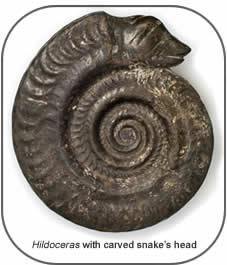
Image: Natural History Museum



